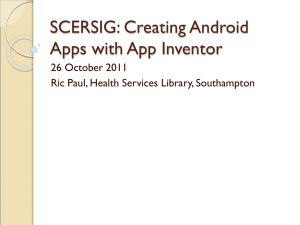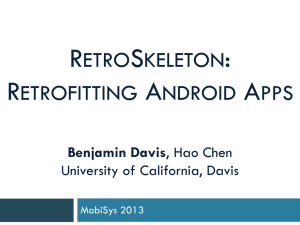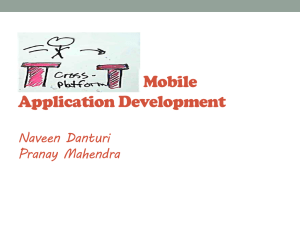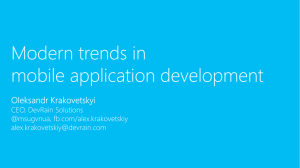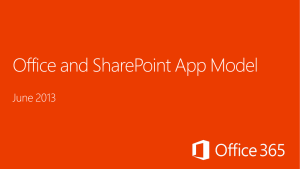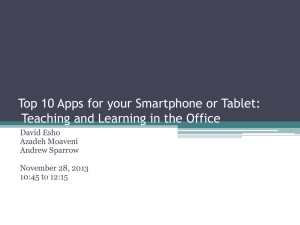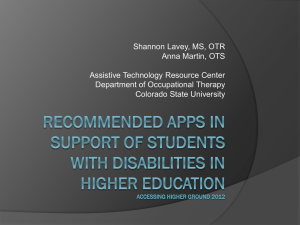Document
advertisement
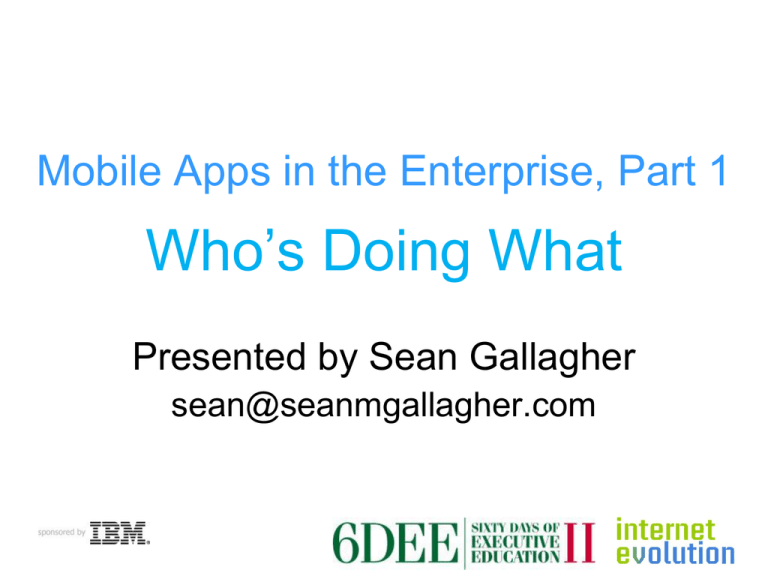
Mobile Apps in the Enterprise, Part 1 Who’s Doing What Presented by Sean Gallagher sean@seanmgallagher.com Two Worlds of Mobile Apps: Enterprise & Consumer • Mission critical • Bringing home the bacon When Consumer & Enterprise Worlds Collide • Consumer mobile apps have raised expectations for what can be done on a mobile device • Consumer hardware isn't up to field use, but... • Mobile sales forces and other information workers are using consumer mobile devices for business already • Midmarket and smaller companies can use “BYO” technology for mobile apps on consumer devices Mission-Essential Enterprise Mobile Apps Need: • Persistent data, even when no network • Integration with enterprise data • Data integrity • Data security • Built-in I/O for barcodes, etc. • Common support base Which Is Why Enterprise Mobile Platforms Are Generally: • Windows CE .NET • PalmOS • Linux But Customers & Employees Use Other Platforms: • Apple iOS • Google Android • HP/Palm webOS • Research In Motion BlackBerry OS/ BlackBerry Tablet OS • Microsoft Windows Mobile • Symbian (outside of US) The Mobile Platform Market 16 Months Ago... Source: R2Integrated The Market Now Global (Gartner) US Where's Windows? (Nielsen) Mobile Is Pervasive • Smartphones and mobile devices have consumerized mobile technology • Employees and customers increasingly expect “an app for that” Using Consumer Mobile Platforms Is Challenging • “Always connected”... isn't. • “Write once, run anywhere”... doesn't. • Platform fragmentation, even on the same mobile OS • Varying app delivery approaches • Security and loss risks • Standards unevenly applied Today’s Mobile Device • Higher-speed networks • 3G nationwide, “4G” and WiMax in metro areas • WiMax and WiFi mesh for campus coverage • Significant local data storage for offline use, persistent data • Persistent location information (GPS) • Imaging built-in (most smartphones) • “Standard” peripheral interfaces that can be programmatically accessed Trends in Mobile Application Technology • Location-based apps • Cloud-based back-end • Augmented reality • Commercial peripheral devices for business • Square credit card reader • Tablets and bigger smartphones with more screen real estate • Faster networks: 4G comparable to full broadband Commercial Enterprise Apps Have Embraced Consumer Mobile • Cloud SaaS providers • SalesForce.com • Oracle, SAP The Mobile Platform Contenders • Windows Mobile/CE dominated businessto-employee app development, but Windows 7 Mobile is a new platform – and not picking up much market share • Symbian matters overseas Mobile Platforms: Apple iOS • On iPad, iPod, iPhone • 25% of US smart phones • Over 100 million devices in use • 150 million iTunes accounts with credit cards attached Advantages of iOS for Enterprises • • • • • • • • Large customer installed base Rich client capabilities Good Web capabilities Enterprise SDK allows in-house app dev and deployment Growing number of development tool options for client apps HTML5 Web supported Default on-device encryption (but you need to use password for protection) Good backup and restore capabilities Disadvantages of iOS • Single carrier for iPhone (for now) • Customer-facing apps require App Store approval, distributed through Apple • Objective C for native apps, need to pay for SDK • No Flash support, no Java support • No multiprocess multitasking • For-sale apps require approval by Apple, sold through Itunes App Store (Enterprise apps can be self-distributed but need specific phone data) Mobile Platforms:Google Android • “Open-Source” on multiple hardware devices • Based on Linux kernel Advantages of Android • • • • • • • • • • Fastest growing platform, in terms of new device sales Multi-carrier Multi-device Open-source tools Java language based Easy deployment – No gatekeeper Free SDK Flash-friendly, AIR-friendly, HTML5-friendly True multitasking Built-in SQLite DB Android Disadvantages: • Multiple versions in deployment • Not all open-source, really • Apps run in runtime, not native code • Viruses • Device dependencies • Smaller app marketplace • Java is dev language • Oracle FUD Mobile Platforms: BlackBerry OS & BlackBerry Tablet OS • Proprietary OS for BlackBerry phones BlackBerry OS Advantages • Market leader (until recently) • Java-based development • Web-based dev, good HTML5 and JavaScript support • AppWorld distribution for commercial apps • Eclipse plug-in for Java BlackBerry OS Disadvantages • Separate OS for Tablet – uses Adobe AIR • Developers have complained about UI issues • Limited hardware access Mobile Platforms: webOS • Originally PalmOS, acquired by HP • New tablet devices planned • Proprietary, but based on Linux WebOS Advantages • Javascript/Web or C/C++ dev; most apps require just Web developer skills • Free SDK and frameworks • Free distribution of code • “Homebrew” friendly WebOS Disadvantages • Palm acquired by HP (good for enterprise?) • If apps sold, must be distributed through Palm store • Limited device support now • Relatively small market share for Palm devices Mobile App Development Cross-Platform • Web-based apps • Default approach to cross-platform • Quick way to wire enterprise data to mobile • HTML5 (mostly supported) • JavaScript + CSS • App builders (HTML, CSS,JavaScript) • Phone gap • Appcellerator Titanium • App streaming through VDI Conclusions • Mass-market devices can connect to the enterprise today. • Windows Mobile will be a player in enterprise, but iOS, Android, and BlackBerry OSs will lead for information workers. • Android has the largest potential hardware platform reach, and new devices such as Motorola Atrix make it attractive as a business platform. • Security remains a key issue that is unevenly addressed across platforms.

